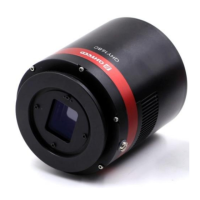QHY168C
7
As we said before, if you are doing planetary imaging you should set the offset value as low as
possible. To make the background close to zero. Then you can easy to get correct color balance.
Otherwise it will not easy to get it. Sometimes the offset of an image is good but you cannot get
good balance.
The reason is that the Color balance is a ratio of the RGB sensitivity difference. So we use a ratio
to multiply the RGB value and get it done. But if there is a bias exist. The ratio will not be correct.
For example, the G sensitivity is the double of R sensitivity.
G=2R In order to get white balance. We multiply a ratio of 2 to R
R'=2R= G so we get R=G
When a bias exist. The bias is a constant added to each pixel. So the image you see is:
R''=R + bias
G' '= G + bias = 2R+bias
Now the ratio R'': G''= (R+bias) / (2R+bias) and it is not equal to 1:2. It shows the bias will affect
the true value of the R:G. And the ratio of R:G will vary when the image light changed. It is hard
to correct with a fixed ratio.
But for DSO capture, you should keep the offset above zero and avoid the background being cut
off. A background from 1000-5000 is a good value (16bit mode) for DSO imaging.

